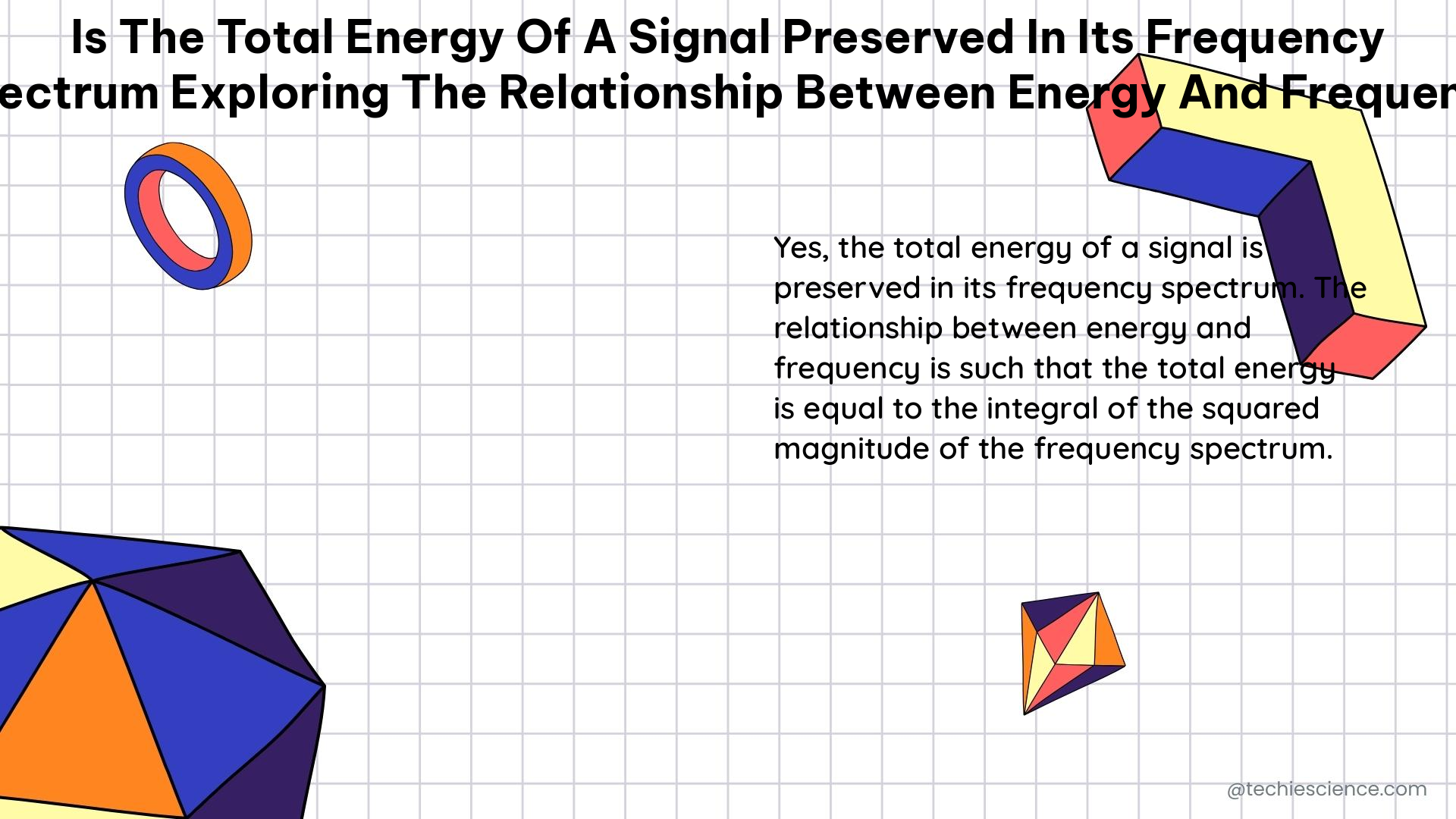The total energy of a signal is indeed preserved in its frequency spectrum, which is a fundamental principle in signal processing and can be demonstrated through various mathematical theorems and formulas. This principle is crucial in understanding the relationship between energy and frequency, and has numerous applications in fields such as communications, control systems, and digital signal processing.
Parseval’s Theorem: The Foundation of Energy Preservation
Parseval’s theorem, also known as Parseval’s identity or Parseval’s equation, is a fundamental theorem in the field of signal processing and Fourier analysis. It states that the sum of the squares of a signal’s time-domain values is equal to the sum of the squares of its frequency-domain values, as shown in Equation 4:
∑n=0N−1∣xn∣2=1N∑k=0N−1∣Xk∣2(4)
Where:
– xn is the time-domain signal
– Xk is the frequency-domain representation of the signal obtained through the Discrete Fourier Transform (DFT)
– N is the number of samples in the input array
This theorem demonstrates that the total energy of a signal is preserved in its frequency spectrum, regardless of the window size or the use of zero-padding or windowing functions. In other words, the energy content of a signal is the same in both the time and frequency domains.
Verifying Energy Conservation Using Parseval’s Theorem

The energy conservation between time and frequency domain results can be further verified using Parseval’s theorem, as demonstrated in the fourth source. The theorem holds for both linear and circular convolution, and the energy of the convolved signal remains unchanged per Parseval’s theorem.
For example, consider a linear convolution between two signals x(t) and h(t), resulting in the output signal y(t). Parseval’s theorem states that the energy of the output signal y(t) is equal to the energy of the input signals x(t) and h(t) in the frequency domain:
∫|y(t)|2 dt = ∫|X(f)H(f)|2 df
Where:
– X(f) is the Fourier transform of x(t)
– H(f) is the Fourier transform of h(t)
This equation demonstrates that the total energy of the output signal is preserved, even after the convolution operation, which is a fundamental property in signal processing.
Energy Preservation in Frequency Modulation
Furthermore, frequency modulation preserves the energy in the carrier signal, distributing some of the original power to the sidebands, as shown in the fifth source. This conservation of energy result applies to more complex signals than just pure sine waves.
In a frequency-modulated (FM) signal, the carrier signal’s energy is distributed among the carrier and the sidebands. The total energy of the FM signal is equal to the energy of the carrier signal before modulation. This can be expressed mathematically as:
E_FM = E_carrier
Where:
– E_FM is the total energy of the frequency-modulated signal
– E_carrier is the energy of the carrier signal before modulation
This property of energy preservation in frequency modulation is crucial in various communication systems, as it ensures that the overall power of the transmitted signal is maintained, even after the modulation process.
Implications and Applications
The preservation of the total energy of a signal in its frequency spectrum is a fundamental principle in signal processing and has numerous implications and applications:
-
Spectral Analysis: The energy preservation property allows for accurate spectral analysis of signals, as the energy content in the frequency domain accurately represents the energy content in the time domain.
-
Filter Design: When designing filters, the energy preservation principle ensures that the energy of the filtered signal is maintained, which is essential for maintaining the signal-to-noise ratio and overall system performance.
-
Communications: In communication systems, the energy preservation property is crucial for ensuring efficient power allocation and transmission, as well as for maintaining the integrity of the transmitted information.
-
Control Systems: In control systems, the energy preservation principle is important for analyzing the energy content of signals and ensuring the stability and performance of the system.
-
Digital Signal Processing: The energy preservation property is a fundamental concept in digital signal processing, where it is used in various algorithms and techniques, such as the Discrete Fourier Transform (DFT) and digital filtering.
Conclusion
In summary, the total energy of a signal is indeed preserved in its frequency spectrum, as demonstrated by Parseval’s theorem and other mathematical principles in signal processing and Fourier analysis. This fundamental principle is crucial in various applications, including signal processing, communications, and control systems. Understanding the relationship between energy and frequency is essential for the effective design and analysis of a wide range of electronic and communication systems.
References
- How is energy conserved for discrete Fourier transforms of different bin size? – Physics Stack Exchange
- Using Parseval’s theorem to check for energy conservation between time and frequency domain results from an FDTD simulation – ANSYS Optics
- Energy-preserving convolution kernel? – DSP Stack Exchange
- Energy in frequency modulated signals – John D. Cook
- Parseval’s theorem – Wikipedia

The lambdageeks.com Core SME Team is a group of experienced subject matter experts from diverse scientific and technical fields including Physics, Chemistry, Technology,Electronics & Electrical Engineering, Automotive, Mechanical Engineering. Our team collaborates to create high-quality, well-researched articles on a wide range of science and technology topics for the lambdageeks.com website.
All Our Senior SME are having more than 7 Years of experience in the respective fields . They are either Working Industry Professionals or assocaited With different Universities. Refer Our Authors Page to get to know About our Core SMEs.